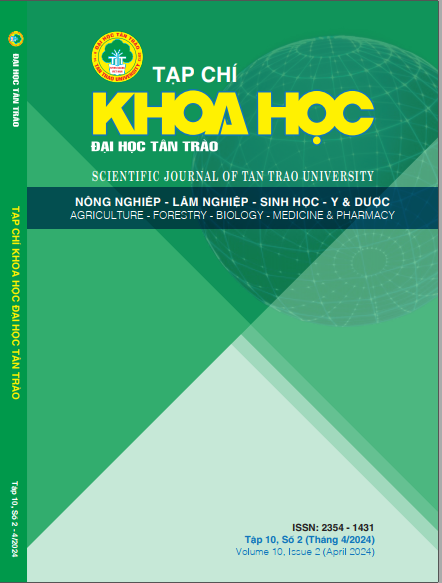RESEARCH ON REARING ANGUILLA MARMORATA AT NHAT NAM SEAFOOD SINGLE SHARE-HOLDER LIMITED COMPANY, TUYEN QUANG PROVINCE.
DOI:
https://doi.org/10.51453/2354-1431/2024/1125Keywords:
Anguilla marmorata, Fish breeding nursery, level I breedAbstract
Experimental rearing of Anguilla marmorata in tanks in Na Hang Tuyen Quang district with a stocking density of 500 fish/m3; Powdered synthetic food with minimum protein content (P) = 48-50%, lipid: ≥ 4.0, fiber ≤ 3.0, moisture ≤ 10; calcium 2.0 - 5.0; ash ≤ 17 and mixed with vitamins, digestive enzymes, minerals; Diet: 3-5% of fish weight/day, adjusted according to the fish's ability to catch prey; Fish feeding time is at 8:00 a.m. and 6:00 or 7:00 p.m. daily; Water pH from 7 - 8; temperature 23-30oC; DO >5 mg/l. The results of rearing show that after 3 rounds of stocking rearing, the growth rate of fish is quite good. In the first round, the survival rate is the lowest (73%), and later on, the survival rate is higher (80%). Weight increases on average 6-7 grams/month, length 4-6cm/month. Total herd weight = 1,993.0 kg, average size ± 50 grams/head.
Downloads
References
Hoang Van Duat and co-workers 2015. Improving technology for nursery and commercial raising of Anguilla marmorata in industrial form. Report the results of national projects under the program of Research, Application and Development of Technology for the Production of Key Products, Code KC.06.DA 11/19-15.
Le Hoang 2008. Techniques for rearing Anguilla spp. Disseminating knowledge about Vietnamese fisheries promotion.
Ly Van Khanh, Tran Thi Thanh Hien, Tran Ngoc Hai, Can Tho University 2013. Experimental rearing of Anguilla marmorata eel with different types of food in a water circulation system. Can Tho University Journal of Science No. 26 (2013): 143-148.
Downloads
Published
How to Cite
Issue
Section
License

This work is licensed under a Creative Commons Attribution-ShareAlike 4.0 International License.
All articles published in SJTTU are licensed under a Creative Commons Attribution-ShareAlike 4.0 International (CC BY-SA) license. This means anyone is free to copy, transform, or redistribute articles for any lawful purpose in any medium, provided they give appropriate attribution to the original author(s) and SJTTU, link to the license, indicate if changes were made, and redistribute any derivative work under the same license.
Copyright on articles is retained by the respective author(s), without restrictions. A non-exclusive license is granted to SJTTU to publish the article and identify itself as its original publisher, along with the commercial right to include the article in a hardcopy issue for sale to libraries and individuals.
Although the conditions of the CC BY-SA license don't apply to authors (as the copyright holder of your article, you have no restrictions on your rights), by submitting to SJTTU, authors recognize the rights of readers, and must grant any third party the right to use their article to the extent provided by the license.


